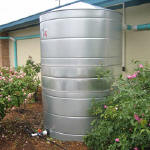Rainwater Harvesting (RWH) is a technique used to supplement, or entirely replace, the water supplied to a home or business by a municipal water system or well by diverting, collecting, and storing for later use rainwater runoff. The idea of collecting rainwater and storing it in cisterns has been around for centuries. But today, there is a renewed interest in Rainwater Harvesting as the demand for and cost of domestic water rises, the available supply of domestic water decreases, and there is increased concern over the chemicals added to water by both the treatment process and by pharmaceutical waste.
The size, complexity, and uses of a Rainwater Harvesting system can range anywhere from a small backyard rain 
Pros and Cons
Some of the benefits of Rainwater Harvesting are that the rainwater itself is free, it has a nearly neutral pH, is sodium-free, contains no excess chemicals, garden plants and vegetables love it, and it can reduce your water bill. Several states offer sales tax exemptions for RWH components and some cities also offer rebates. Although the rainwater itself is free, there is certainly a cost associated with the purchase, installation, and upkeep of a RWH system. Typically, a whole house RWH system is more expensive than using your municipal water supply, but can be significantly less expensive than having a well drilled. Although largely unregulated for private residential usage, there are some state and local municipalities that have enacted legislation regarding RWH.
Key Factors
There are three key factors to consider in evaluating, planning, and designing a RWH system:
1) Planned Use: will the water be used for irrigation, livestock and pets, indoor home usage, or a combination of the above.
2) Estimated Demand: how much water will you need to meet your planned uses.
3) Potential Capture Amount: what is the average annual and monthly rainfall for your area, what is the typical intensity and frequency of your rainfall, and how large of a capture area, usually a roof, do you have.
Basic Components
According to the Texas Water Development Board, a Rainwater Harvesting system consists of six basic components:
1) Catchment Surface – the collection surface from which rainfall runs off of such as a roof.
2) Gutters and Downspouts – channel the water to the storage tank.
3) Pre-storage Filtration – leaf screens and first-flush diverters that remove debris from the rainwater before it enters the storage tank.
4) Storage Tank(s) – one or more containers of varying sizes typically made from corrugated steel, concrete, wood, fiberglass, polyethylene, or polypropylene plastic.
5) Treatment & Purification – filters and purification devices to make harvested rainwater safe to drink such as reverse osmosis, nanofiltration, activated carbon filtration, ozonation, and UV light.
6) Delivery System – water is gravity-fed or pumped from storage to where it is to be used, a plant in the garden or the faucet in your kitchen.
Planned Use
What you plan on using your harvested rainwater for will greatly affect the equipment required for filtration, treatment, and purification. If you just plan on watering your garden or lawn, a simple piece of screen placed under your downspout to keep leaves from entering the storage container will suffice. Rainwater collected for drinking will require several additional treatment and purification devices.
Estimate Demand
You will want to come up with an accurate picture of your annual, monthly, and daily water usage. Look at your water bills for the past year and note the average gallons of water used for months when you are watering your lawn and garden versus winter months. On average, each person in an average household uses about 41.5 gallons of indoor water each day. During the summer watering an average size lawn can use 1,800 gallons of water each day.
Potential Capture Amount
Determine the catchment area of your house by calculating the number of square feet in its footprint by multiplying the length of your house by its width. The number of stories does not matter nor does the shape of the roof. Now use the following formula to estimate the number of gallons of rainwater that can be harvested from any given rain event:
Harvested Water (gal) = catchment area (sq.ft.) X inches of rainfall X 0.623
That means that one inch of rainfall on a 1000 sq. ft. roof will provide 623 gallons of harvested rainwater.
Use this link to the National Climatic Data Center to find the Average Monthly Rainfall for your area for each month of the year. Plug that amount into the formula above to come up with a rough estimate of the Monthly Potential for gallons of rainwater that can be captured each month.
Storage Capacity
Once the average potential rainwater capture amount is determined, you will want to calculate your desired storage capacity. Because it doesn’t rain the exact same amount each day or month, you will want to have enough rainwater stored to last through periods of little or no rain. A quick and easy way to do this is to plan on storing enough to meet three months of demand. You want to have enough water stored to meet your needs but keep in mind that the larger the storage tank(s), the more they cost.
Summary
OK, wow. I started off wanting to write a quick article on how to cut a hole in the top of an old 55 gallon drum, stick a faucet in it, put it under your downspout and then go water your vegetables. Instead, I ended up with some technical manual talking about potential capture amount formulas, nanofiltration, and global conspiracies to ship all of our water to China. Maybe I should cut back on my coffee intake a little. I hope you found this information useful, or that at the very least, you did not suffer a severe head injury after your head hit the desk when you fell asleep halfway through the ninth paragraph.
If you have any questions, would like any additional information, or just want to recommend a good brand of decaf, be sure to leave a comment. Until next time, How Do!

